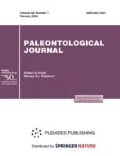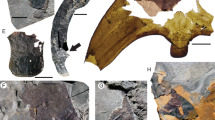Abstract
One of the earliest isorophid edrioasteroids from the upper Middle Cambrian-lower Upper Cambrian (upper part of Series 3-lower part of the Furongian Series) of northern Iran is described. It has unusual branched ambulacra, which extend beyond the theca almost to the marginal rim. These unusual features reflect the latent possibility of appearance of separated from the theca and even branching food-gathering appendages, such as arms in crinoids and brachials in blastozoans, in common ancestor of all radially symmetrical echinoderms.
Similar content being viewed by others
References
Bell, B.M., A study of North American Edrioasteroidea, Mem. New York State Mus., 1976, vol. 21, pp. 1–447.
Gehling, J.G., Earliest known echinoderm—a new ediacaran fossil from the Pound Subgroup of South Australia, Alcheringa, 1987, vol. 11, no. 4, pp. 337–345.
Guensburg, T.E. and Sprinkle, J., Revised phylogeny and functional interpretation of the Edrioasteroidea based on new taxa from the Early and Middle Ordovician of western Utah, Fieldiana (Geol.)., 1994, no. 29, pp. 1–43.
Hamdi, B., Precambrian and Cambrian geology of Alborz Mountains, Northern Iran, in International Field Meeting in Iran, September 6–13, 1996, IGCP Project 366: Excursion Guidebook, 1996, p. 36.
Holloway, D.J. and Jell, P.A., Silurian and Devonian edrioasteroids from Australia, J. Paleontol., 1983, vol. 57, no. 5, pp. 1001–1016.
Kruse, P.D. and Zhuravlev, A.Yu., Middle-Late Cambrian Rankenella-Girvanella reefs of the Mila Formation, northern Iran, Can. J. Earth Sci., 2008, vol. 45, no. 6, pp. 619–639.
Paul, C.R.C. and Smith, A.B., The early radiation and phylogeny of echinoderms, Biol. Rev., 1984, vol. 59, no. 4, pp. 443–481.
Popov, L., Kebria-ee Zaden, M.,R., Pour, M.G., et al., Cambrian (Furongian) rhychonelliform brachiopods from the Eastern Alborz Mountains, Iran, Bull. Geosci., 2013, vol. 88, no. 3, pp. 525–538.
Rozhnov, S.V. and Ivantsov, A.Yu., Echinoderm-like fossils from the White Sea (Russia): Problems of identification, in Abstracts of 21ème Reunion des Sciences de la Terre (Dijon, 2006), Dijon, 2006, p. 40.
Rozhnov, S.V. and Ivantsov, A.Yu., Problems of identification of the Vendian echinoderms, in The Rise and Fall of the Vendian (Ediacaran) Biota: Origin of the Modern Biosphere (Transaction of the International Conference on the IGCP Project 493), Moscow: Geos, 2007, pp. 21–27.
Smith, A.B., Fossil evidence for the relationships of extant echinoderm classes and their times of divergence, in Echinoderm Phylogeny and Evolutionary Biology, Paul, C.R.C. and Smith, A.B., The early radiation and phylogeny of echinoderms, Biol. Rev., 1984, vol. 59, no. 4, pp. 443–481.
Smith, A.B. and Jell, P.A., Cambrian edrioasteroids from Australia and the origins of starfishes, Mem. Queensl. Mus., 1990, vol. 28, pp. 715–778.
Smith, A.B. and Paul, C.R.C., Revision of the class Cyclocystoidea (Echinodermata), Phil. Trans. Roy. Soc. London Ser. B, 1982, vol. 296, pp. 577–684.
Sumrall, C.D., Sprinkle, J., and Guensburg, T.E., Systematics and paleoecology of Late Cambrian echinoderms from the western United States, J. Paleontol., 1997, vol. 71, no. 6, pp. 1091–1109.
Zamora, S., Morphology and phylogenetic interpretation of a new Cambrian edrioasteroid (Echinodermata) from Spain, Palaeontology, 2013, vol. 56, no. 2, pp. 421–431.
Zamora, S., Liñán, E., Domínguez Alonso, P., et al., AMiddle Cambrian edrioasteroid from the Murerobiota (NE Spain) with Australian affinities, Ann. Paleontol., 2007, vol. 93, no. 4, pp. 249–260.
Zamora, S. and Smith, A.B., The oldest isorophid edrioasteroid (Echinodermata) and the evolution of attachment strategies in Cambrian edrioasteroids, Acta Palaeontol. Polon., 2010, vol. 55, no. 3, pp. 487–494.
Zamora, S., Sumrall, C.D., and Vizcaïno, D., Morphology and ontogeny of the Cambrian edrioasteroid echinoderm Cambraster cannati from western Gondwana, Acta Palaeontol. Polon., 2013, vol. 58, no. 3, pp. 545–559.
Zhao, Y., Sumrall, C.D., Parsley, R.L., and Peng, J., Kailidiscus, a new plesiomorphic edrioasteroid from the basal Middle Cambrian Kaili Biota of Guizhou Province, China, J. Paleontol., 2010, vol. 84, no. 4, pp. 668–680.
Author information
Authors and Affiliations
Corresponding author
Additional information
Original Russian Text © T.E. Guensburg, S.V. Rozhnov, 2014, published in Paleontologicheskii Zhurnal, 2014, No. 4, pp. 60–65.
Rights and permissions
About this article
Cite this article
Guensburg, T.E., Rozhnov, S.V. A unique edrioasteroid from the upper Middle Cambrian of Iran, its phylogenetic implications and paleoecology. Paleontol. J. 48, 401–406 (2014). https://doi.org/10.1134/S0031030114040078
Received:
Published:
Issue Date:
DOI: https://doi.org/10.1134/S0031030114040078




